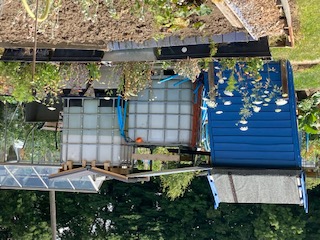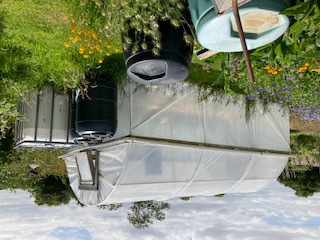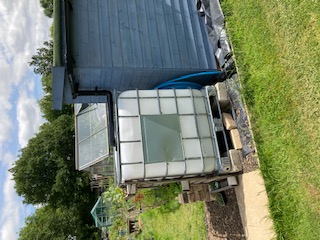Water conservation
Water conservation
Water
Conservation
As yet we do not have water on site. Many sub-tenants already collect water from their structures in to IBCs and blue barrels. It is a condition of your tenancy to practice water conservation with all structures to have rain water collecting systems and covered storage, clauses 4.8.3 and 4.8.5.
There is a useful NSALG reference about how to do this:
www.nsalg.org.uk/growing-advice/gardening-advice/water-use-on-allotments/
For a poly tunnel this video clip is an easy, cheap solution.
https://www.youtube.com/watch?v=AIyzCGB-Muc
Another link to handy hint is
https://www.bing.com/videos/search?q=Fitting+aguttering+to+a+polytunnel.&view=detail&mid=C5FD980F880B235E9FF1C5FD980F880B235E9FF1&FORM=VIRE
This is a link to a commercial solution:
https://www.premierpolytunnels.co.uk/shop/accessories/polytunnel-gutters/
In addition there are some basic techniques that will help in the wise use of water on an allotment.
Soil Improvement
1 Adding organic matter such as compost or manure increases the soil’s ability to absorb and store water. It creates airy friable soil which allows roots to penetrate more deeply in search of water, and it will encourage water penetration and retention.
There is a ‘communal manure heap’ for members. This is charged at £1 per THREE barrow loads.
2.Create your own compost heap where you can dispose of your green kitchen waste and add the green waste from your plot. To this you can add leaves, grass cuttings and cuttings. To help the composting process add cardboard (ideally the brown packaging). This will be a ‘cold compost heap’ as there is little heat, so to speed things up go over the material with a mower to break it into smaller pieces. It takes a lot longer to rot down as it does not rely on the heat element, but weeds, pruning's and woody waste will rot down eventually. You can add a commercial activator or use comfrey leaves to activate the process.
Use the resulting compost to improve your soil.
You can build a simple compost bin from four pallets knocked together or simply put the compost material in a sack or an old compost bag, tie it up and leave.
3 Mulching—organic. Water is lost when it evaporates from exposed soil. Applying a 3 to 5 inch layer of mulch can significantly reduce this water loss. A good mulch can also suppress weed growth. Weeds compete for available water. It can also prevent soil compaction thus allowing rain to penetrate rather than run off.
Wood chip, bark, grass cuttings, compost and manure with straw can all be used as an organic mulch. Always mulch after a good rainfall, and not when the ground is dry.
4 Mulching weed suppressing materials can also conserve moisture if laid on damp soil. It will also suppress weed growth and help to warm up the soil early in the season. Do not use carpets as these contain harmful chemicals which may leach into the soil.
5 Cultivation and planting Some methods of cultivation are more conducive to water conservation than others. A deep bed system is a deeply worked and well manured area which help to make the soil friable and fertile and the water will be able to penetrate to greater depth. As a result of the plant cover, evaporation from the soil surface will be reduced to a minimum.
6 Cultivation and planting Frequent shallow hoeing with a Dutch or push hoe will take care of the weeds and also keep the soil surface loose, allowing any rain water to be absorbed rather than running off.
To economise on watering, it is possible to group your plants together according to their watering requirements. For example, thirsty plants such as courgettes, marrows, tomatoes and cucumbers will all grow happily together. When planted fairly close, their leaves help to reduce water loss by evaporation.
7 Cultivation and planting Many plants such as spinach, chard, parsley, lettuce and other leafy crops, prefer moist growing conditions. In order to maximise water retention, these can be planted in shallow trenches which can be used for watering.
As our climate is becoming warmer, growing in the full sun can be a problem. It is possible to get good results by using the shade produced by other plants. Parsley and spinach for example, appreciate the shade cast by runner beans.
8 Cultivation and planting If the soil surface is hoed to maintain a fine dry tilth layer, it will lose very little water. This dry layer will then help to preserve moisture at a lower level.
9 Well pruned fruit trees and soft fruit require less water to maintain good productivity as they lose less moisture through transpiration from excess leaves.
10 Choosing the right crop. Use the seed catalogues to look for drought resistant or non bolting varieties. To give seedlings the best chance of getting away, plant them out late in the day if it’s hot to prevent the moisture evaporating so quickly. Water them in well, but then draw dry soil up round them to fool the slugs. Plan your planting so that crops which require more water are grown closer to a water source.
Watering
11 Watering wisely Water is a scarce resource and it should be used responsibly. Avoid water as a matter of routine rather water according to their actual requirements. On a hot day about 25% of water can be lost to evaporation before it benefits the plants. Apply water slowly, so it can be absorbed by the soil and the roots. An occasional soaking is better than little and often. Water early or late in the day, less water will be lost in evaporation, as the temperature is lower, humidity is higher and the air is calmer. Frequent surface watering encourages the roots up towards the moisture where they are at risk in hot dry periods.
12 No dig or minimal digging This approach does not use deep digging nor rotovating of the soil. The concern is that this destroys underlying soil structure and opens up the soil to evaporation. Preparation is important. In autumn, cover the area with a thick layer of mulch, organic matter like a green manure, manure or compost. Avoid walking on the area. When preparing the bed sowing in spring, the mulch layer would have suppressed weeds and protected the soil from compaction by the rain over winter. This well rotted mulch layer can be gently turned into the top of the soil ready for planting. Over a few years the soil structure will improve and become more friable to work.
Further hints and advice can be found on these links to the NSALG site: https://www.nsalg.org.uk/
Introduction to drought, climate change and growing Introduction to sustainable water collection and use on allotments Advanced sustainable water collection and irrigation on allotments
As yet we do not have water on site. Many sub-tenants already collect water from their structures in to IBCs and blue barrels. It is a condition of your tenancy to practice water conservation with all structures to have rain water collecting systems and covered storage, clauses 4.8.3 and 4.8.5.
We are able to supply IBCs at £40 each. Availability depends on supply. If you would like an IBC please contact the Secretary.
There is a useful NSALG reference about how to do this:
www.nsalg.org.uk/growing-advice/gardening-advice/water-use-on-allotments/
For a poly tunnel this video clip is an easy, cheap solution.
https://www.youtube.com/watch?v=AIyzCGB-Muc
Another link to handy hint is
https://www.bing.com/videos/search?q=Fitting+aguttering+to+a+polytunnel.&view=detail&mid=C5FD980F880B235E9FF1C5FD980F880B235E9FF1&FORM=VIRE
This is a link to a commercial solution:
https://www.premierpolytunnels.co.uk/shop/accessories/polytunnel-gutters/
In addition there are some basic techniques that will help in the wise use of water on an allotment.
Soil Improvement
1 Adding organic matter such as compost or manure increases the soil’s ability to absorb and store water. It creates airy friable soil which allows roots to penetrate more deeply in search of water, and it will encourage water penetration and retention.
There is a ‘communal manure heap’ for members. This is charged at £1 per THREE barrow loads.
2.Create your own compost heap where you can dispose of your green kitchen waste and add the green waste from your plot. To this you can add leaves, grass cuttings and cuttings. To help the composting process add cardboard (ideally the brown packaging). This will be a ‘cold compost heap’ as there is little heat, so to speed things up go over the material with a mower to break it into smaller pieces. It takes a lot longer to rot down as it does not rely on the heat element, but weeds, pruning's and woody waste will rot down eventually. You can add a commercial activator or use comfrey leaves to activate the process.
Use the resulting compost to improve your soil.
You can build a simple compost bin from four pallets knocked together or simply put the compost material in a sack or an old compost bag, tie it up and leave.
3 Mulching—organic. Water is lost when it evaporates from exposed soil. Applying a 3 to 5 inch layer of mulch can significantly reduce this water loss. A good mulch can also suppress weed growth. Weeds compete for available water. It can also prevent soil compaction thus allowing rain to penetrate rather than run off.
Wood chip, bark, grass cuttings, compost and manure with straw can all be used as an organic mulch. Always mulch after a good rainfall, and not when the ground is dry.
4 Mulching weed suppressing materials can also conserve moisture if laid on damp soil. It will also suppress weed growth and help to warm up the soil early in the season. Do not use carpets as these contain harmful chemicals which may leach into the soil.
5 Cultivation and planting Some methods of cultivation are more conducive to water conservation than others. A deep bed system is a deeply worked and well manured area which help to make the soil friable and fertile and the water will be able to penetrate to greater depth. As a result of the plant cover, evaporation from the soil surface will be reduced to a minimum.
Try
not to do deep digging when it’s dry. This will bring any residual
dampness to the surface where it will be lost by evaporation. If
digging has to be done when it’s hot, cover the ground to conserve
moisture.
6 Cultivation and planting Frequent shallow hoeing with a Dutch or push hoe will take care of the weeds and also keep the soil surface loose, allowing any rain water to be absorbed rather than running off.
To economise on watering, it is possible to group your plants together according to their watering requirements. For example, thirsty plants such as courgettes, marrows, tomatoes and cucumbers will all grow happily together. When planted fairly close, their leaves help to reduce water loss by evaporation.
7 Cultivation and planting Many plants such as spinach, chard, parsley, lettuce and other leafy crops, prefer moist growing conditions. In order to maximise water retention, these can be planted in shallow trenches which can be used for watering.
As our climate is becoming warmer, growing in the full sun can be a problem. It is possible to get good results by using the shade produced by other plants. Parsley and spinach for example, appreciate the shade cast by runner beans.
8 Cultivation and planting If the soil surface is hoed to maintain a fine dry tilth layer, it will lose very little water. This dry layer will then help to preserve moisture at a lower level.
9 Well pruned fruit trees and soft fruit require less water to maintain good productivity as they lose less moisture through transpiration from excess leaves.
10 Choosing the right crop. Use the seed catalogues to look for drought resistant or non bolting varieties. To give seedlings the best chance of getting away, plant them out late in the day if it’s hot to prevent the moisture evaporating so quickly. Water them in well, but then draw dry soil up round them to fool the slugs. Plan your planting so that crops which require more water are grown closer to a water source.
Watering
11 Watering wisely Water is a scarce resource and it should be used responsibly. Avoid water as a matter of routine rather water according to their actual requirements. On a hot day about 25% of water can be lost to evaporation before it benefits the plants. Apply water slowly, so it can be absorbed by the soil and the roots. An occasional soaking is better than little and often. Water early or late in the day, less water will be lost in evaporation, as the temperature is lower, humidity is higher and the air is calmer. Frequent surface watering encourages the roots up towards the moisture where they are at risk in hot dry periods.
12 No dig or minimal digging This approach does not use deep digging nor rotovating of the soil. The concern is that this destroys underlying soil structure and opens up the soil to evaporation. Preparation is important. In autumn, cover the area with a thick layer of mulch, organic matter like a green manure, manure or compost. Avoid walking on the area. When preparing the bed sowing in spring, the mulch layer would have suppressed weeds and protected the soil from compaction by the rain over winter. This well rotted mulch layer can be gently turned into the top of the soil ready for planting. Over a few years the soil structure will improve and become more friable to work.
Further hints and advice can be found on these links to the NSALG site: https://www.nsalg.org.uk/
Introduction to drought, climate change and growing Introduction to sustainable water collection and use on allotments Advanced sustainable water collection and irrigation on allotments
Growing
drought resistant crops on allotments
Ground
level rainwater collection on allotments
Climate
predictions for allotments
updated 16th January 2023
updated 16th January 2023

Water conservation
.

Water conservation

Water conservation

